While auditioning for a family Christmas commercial in Los Angeles, actors Elizabeth Bemis and Gabriel Villanueva made a bold choice.
After hitting their marks and delivering their lines as a married couple, the pair leaned in for a quick peck on the lips. The sweet, unscripted moment lasted less than a second, but elicited quite a reaction.
“What was that?!” exclaimed the casting director from behind his mask and face shield.
“Can’t do that unless you’re quarantining together!” quipped the camera operator from several feet away.
Actually, Bemis and Villanueva couldn’t have auditioned at all — let alone kissed — unless they were quarantining together. It wasn’t the first time the Central L.A. residents, who have been dating for more than six years, had auditioned as a couple amid the COVID-19 pandemic, which has forced the entertainment industry to adapt to stricter health and safety protocols.
Often that involves auditioning remotely via Zoom or self-tapes, which actors film from their homes and submit online. In this case, it meant auditioning in person — with a quarantine buddy — for characters required to come within (gasp!) six feet of each other.
“It’s interesting because before the pandemic, we would get an audition together maybe, like, once a month?” Bemis told The Times last month, speaking through a floral cloth mask in the empty waiting room of the 200 South casting studio on La Brea Avenue. “Maybe even less. ... And now we’re getting them way more than we’re getting individuals.”
“With the production rules in California ... even the way actors interact on set — there’s a protocol for that now, so people can’t kiss unless you’re quarantining together,” Villanueva said through a blue surgical mask. “So we kissed.”
As Hollywood begins to resume production, actors and casting directors are navigating a whole new world for auditions: Socially distanced studio layouts, elaborate self-tape setups and awkward Zoom meetings.
The Times recently observed the audition process at 200 South, speaking with actors about their experiences auditioning both in-person and at home during the pandemic. Via phone, casting directors also shared their thoughts on how the public health emergency has altered casting in TV, film and beyond.
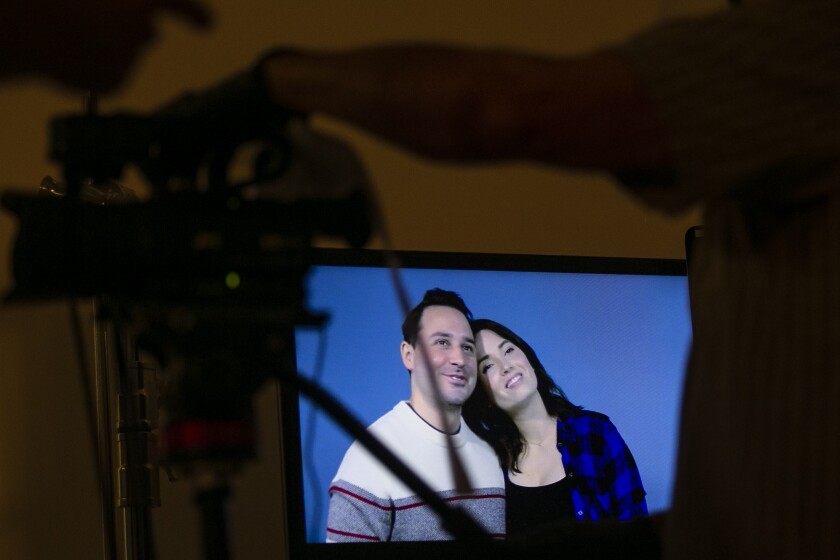
Actors Gabriel Villanueva, left, and Elizabeth Bemis for a commercial at 200 South.
(Josie Norris / Los Angeles Times)
America’s craftiest home videos
The self-tape has long been a staple of the Hollywood casting process, but the recent dearth of in-person opportunities has pushed actors to step up their home video skills — acquiring ring lights, iPhone tripods, backdrops and other accessories to keep up with their remote competition.
“Self-taping at home, I find to be more anxiety-provoking, stressful, cumbersome than coming here and doing it in person,” said Villanueva — who described one of his and Bemis’ home setups as “a very sophisticated stacking of cardboard boxes.” “You would think it’d be more convenient to just do it at home, but it’s really not.”
In addition to the role for which they’re auditioning, actors must now also play the part of producers, editors, readers, camera operators and directors when shooting from home.
“We live in a very cramped, small apartment, so anytime we have to do a self-tape, we have to move a table out of the way. We have to take things off the walls. We’ve gotta set up the light. We’ve gotta set up the camera,” agreed actress Jocelyn Hall of Los Feliz.
“It’s a whole sweaty process — ‘cause it’s also like a million degrees in California right now ... So when we do get a chance to go in person, I love it because I don’t have to think about any of the technical aspects. I don’t have to make sure the lighting is right. I don’t have to make sure the camera is at the right angle.”
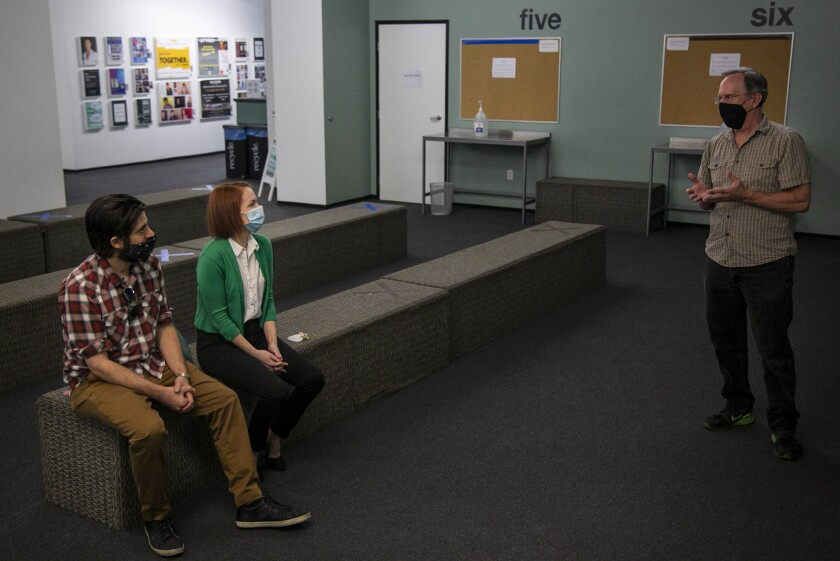
Musician Matt Grossman, left, and actress Jocelyn Hall receive instructions from camera operator Dave Reifsnyder before a commercial audition at 200 South. Grossman and Hall were able to safely audition together because they are a real couple living together in quarantine. The former is not an actor but has been joining his girlfriend for couples auditions amid the pandemic.
(Josie Norris / Los Angeles Times)
One major upside, of course, of filming your own audition is the number of do-overs you get to land the material — a luxury not afforded in the high-stakes realm of in-person auditions, which typically offer limited time to make an impression.
“Now that self-tapes are the new normal, you can deliver your best tape,” said casting director Julia Kim, who recently worked on the Sundance Film Festival breakout “Minari.” “You could practice as much as you want behind the scenes and settle on the tape that you want to deliver to us. So right there, you have the advantage.”
For casting veterans like Kim, reviewing self-tapes is nothing new, but the extra effort from actors definitely is. Casting Society of America board member Zora DeHorter has been particularly impressed by performers repurposing their home environments as makeshift sets — shooting a forest scene in a nearby park, for example, or a hitchhiking sequence on a road with a real car.
“During the normal time, because you’re running around so much, it’s usually just a white wall. They do it quickly, and they send it to you — which is fine,” said the casting director, who recently worked on the 2019 action thriller “Shadow Wolves.”
“I’m not knocking that at all. ... But now I feel like there are more actors going above and beyond and going to a location and setting it up and dressing a certain way and getting into it and adding music. I’m blown away now by some of the stuff I’ve seen.”
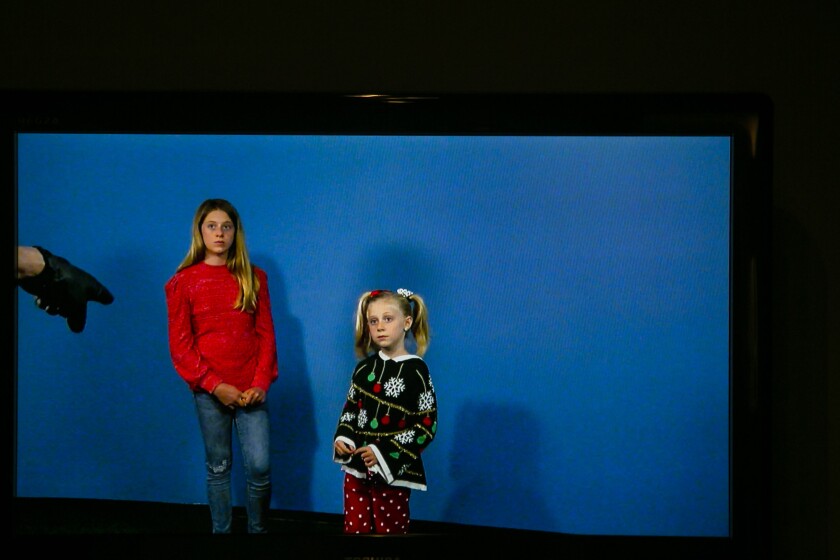
Sisters Chloe Bowling, 12, and Brooke Bowling, 6, receive instruction during a commercial audition at 200 South. The siblings were able to audition together because they are living together in quarantine.
(Josie Norris / Los Angeles Times)
While auditioning for family projects from their Woodland Hills home, actress Colleen Bowling, her husband and their four children have gotten especially creative with self-tapes — browsing Target for toy commercial props, building a fire in their backyard for a summer-camp sequence and even sprinkling in voiceover effects to convey inner thoughts.
“I feel like it’s challenging us,” Bowling said. “[It has provided] opportunity for newer actors, and it’s just allowed us to get really smart about the industry quickly — forcing us to do our own technology and editing. We’ve really become pros on iMovie.”
Actors, they’re just like us — on Zoom
Out of the pandemic, a new strain of audition horror stories has emerged: the botched Zoom call.
“There’s that awkwardness that happens quite often,” DeHorter said, “where they’re not grasping the technology part of how to unmute and then, sometimes, even leave the meeting.”
Crowded audition waiting rooms have been replaced with virtual ones on Zoom, where actors have no choice but to stare blankly at their competition through muted, “Brady Bunch"-style boxes at all times — lest they miss their visual cue to enter the online audition room. (Full disclosure: Times owner Dr. Patrick Soon-Shiong is an investor in Zoom.)
“Normally if you come in [to the studio], sometimes you’ll chat with another actor, or even if you don’t, it’s not weird,” Bemis said. “But for some reason, there’s something about being on Zoom that makes it kind of uncomfortable because you’re just, like, staring at each other.”
For the most part, actors and casting directors agree that video chatting is an effective alternative to live auditions — especially in the callback stages, where filmmakers, producers and other creatives can join the virtual meeting to review the finalists.
As long as everyone’s internet connection is intact.
“There’s been fun, happy accidents — whether a pet crawls into the frame or just unexpected things that bring us all on the same page that we’re all in this together,” Kim said. “But ... sometimes [the audio will] drop out while they’re in the middle of something intense, and I hate that I have to say ... ‘You just poured your heart and soul into that, but I’m gonna have to ask you to do it again because I need a clean take.’”
Zoom has also allowed casting professionals like Kim, who is on the CSA’s Equity in Entertainment committee, to connect with and counsel actors from marginalized groups trying to break into Hollywood.
Before the pandemic, Kim and her colleagues launched a project aimed at creating more opportunities in the industry for actors of color, as well as performers from LGBTQ and disability communities.
“A lot of the downtime has been getting acquainted with actors that we wouldn’t ordinarily have the time to always meet, because we really need to meet actors that are appropriate for a project that we’re working on,” Kim said. “But since projects are few and far between, it gives us more flexibility to just meet somebody because they’re interesting and keep them under our hat for the future.”
Casting director Carla Hool, who often works with international talent, is used to interacting with actors remotely through a screen. Still, certain advanced aspects of the process, like chemistry reads typically staged with multiple actors in proximity, are near “impossible to have right now without breaking the rules.”
“I do miss getting to know the actor’s personality. They come in and talk, and I get to see another part of them — not just that take of that scene. So that is lost,” said Hool, who recently resumed work on Netflix’s “Selena: The Series.”
“At least right now with Zoom, you can see them. It’s easier, but it’s still not the same as being in the room and seeing the actor in person.”
Back in the (casting) studio
One loophole some agents and casting professionals have used to screen actors in a shared space is the quarantine package: small groups of talent who are already living together and can therefore safely audition together.
An August commercial casting call at 200 South invited real-life couples and sisters to play a father, mother and two daughters celebrating the holidays during the COVID-19 lockdown. Actors were required to wait outside before their audition time, wear face coverings until they were on camera and bring their own props — Christmas ornaments — to avoid contamination.
“The first thing is to err on the side of safety,” said Ross Lacy, casting director and owner of 200 South. “You have to really respect the rules.”
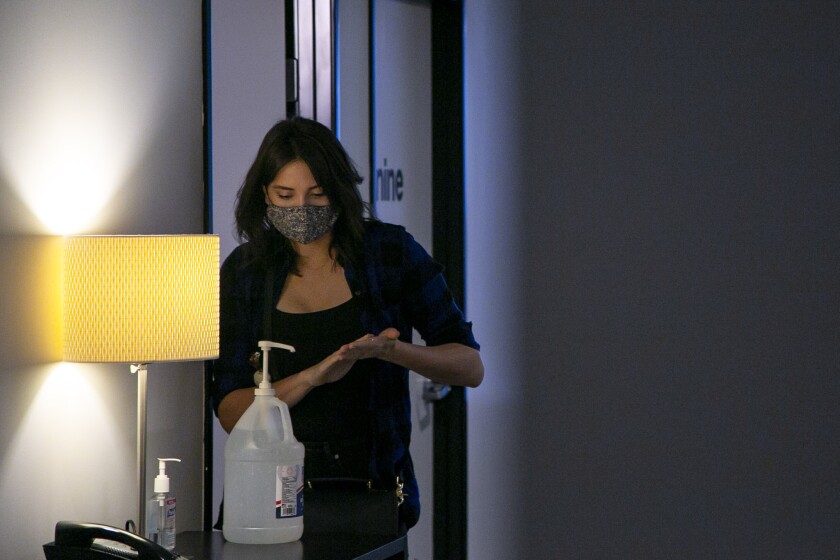
Actress Elizabeth Bemis applies hand sanitizer after a commercial audition at 200 South.
(Josie Norris / Los Angeles Times)
To encourage social distancing between actors, the vast waiting room was covered in masking-tape X marks, spaced six feet apart and color-coded according to audition room.
Printed guidelines posted throughout the mostly vacant, 13,000-square-foot facility reminded visitors to utilize the ubiquitous hand-sanitizing stations, maintain a six-feet distance from camera operators and assistants — who wore shields and face coverings at all times — and “cancel without fear” of retribution should they feel uncomfortable auditioning in person.
“There’s no grudge held by us if someone can’t come in or doesn’t feel comfortable coming in,” Lacy said. “I totally, totally, totally get that. To the actors, I would say, ‘Don’t do anything that you don’t feel safe doing. If you get to an audition and it’s crowded, speak up and say something.’”
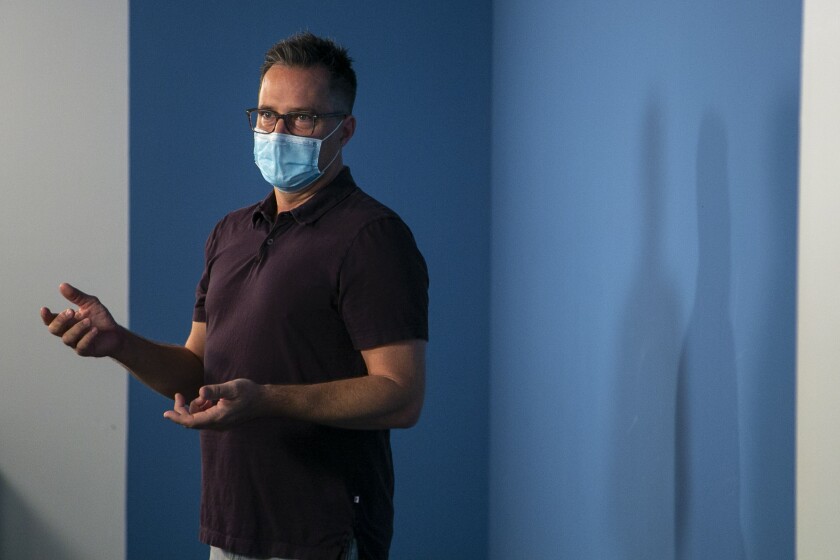
Casting director and 200 South casting studio owner Ross Lacy prepares for in-person auditions.
(Josie Norris / Los Angeles Times)
Comfort didn’t seem to be an issue for the talent auditioning that day, all of whom appreciated the extra precautions taken by 200 South to keep everyone safe. Many preferred acting alongside their real loved ones, as opposed to being paired on the spot with a stranger.
At least right now with Zoom, you can see them. It’s easier, but it’s still not the same as being in the room and seeing the actor in person.
Carla Hool, casting director
“I do like doing auditions with my sisters,” said 12-year-old Chloe Bowling, speaking through a hot-pink face mask. “I hope that stays [after the pandemic] because it’s easy. I feel like I can relate more to them instead of getting another person to pretend to be my sister — which I’m fine with — but it’s been fun because then we can practice together before, and we can really relate to the script.”
Other elements of the new casting normal that directors and actors would like to continue post-pandemic are spacious waiting rooms, more productive Zoom meetings and less commuting — as well as a newfound sense of “camaraderie” between all the filmmakers, casting professionals and performers just doing their best under unprecedented circumstances.
“It’s crazy how, in every single department — every single aspect of our lives — it’s just not going to be back to the way it was,” Hool said. “I don’t think things are ever going to go back to exactly the way they used to be.”
"Hollywood" - Google News
September 25, 2020 at 09:00PM
https://ift.tt/2HoclgK
How COVID-19 has changed Hollywood's audition process - Los Angeles Times
"Hollywood" - Google News
https://ift.tt/38iWBEK
https://ift.tt/3fdiOHW
Bagikan Berita Ini















0 Response to "How COVID-19 has changed Hollywood's audition process - Los Angeles Times"
Post a Comment